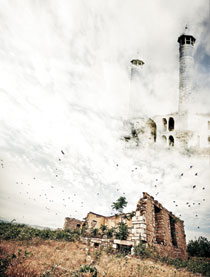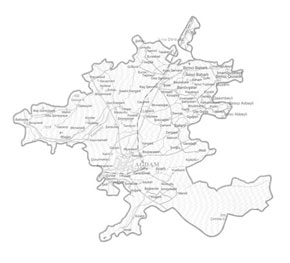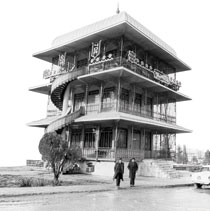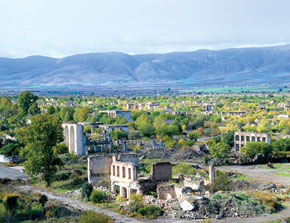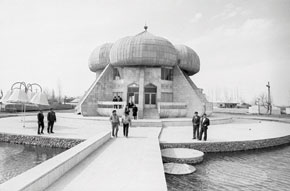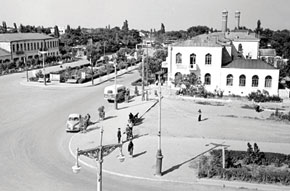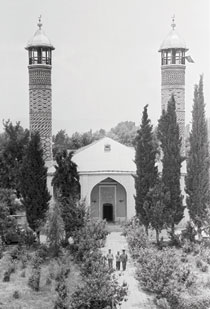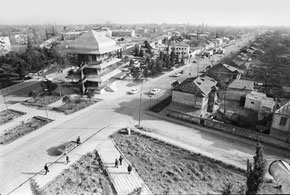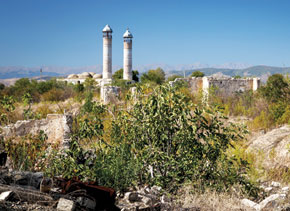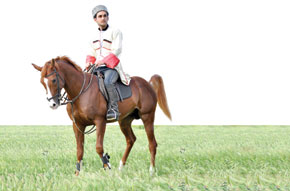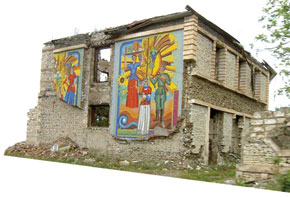23 July 2015 marked 22 years since the beginning of the occupation of Aghdam, in central Karabakh, by Armenian forces. Kerim Kerimli outlines the significance this territory – its white beauty, rich cultural monuments and its symbolic place as the heart of Karabakh.
Aghdam is Karabakh’s heart. Some say that Aghdam is Karabakh’s soul. Both are true. In fact, there is no Aghdam now, only Aghdam’s territory and its ruins, witnesses of the most terrible vandalism of the 20th and 21st centuries. On 29 July 1993, the UN Security Council adopted resolution 853, based on a report by Mario Rafaelli, the former chairperson of the OSCE Minsk Group. It condemned the occupation of Aghdam, called for the immediate, complete and unconditional withdrawal of occupying forces from the area and for the return of refugees to their homes.
Meanwhile, Aghdam has never been so desolate as it is now; it has almost been wiped off the face of the earth. In 2008, Lonely Planet magazine labelled Aghdam the “Hiroshima of the Caucasus” and Aghdam was added to the list of “Ghost Cities” by the online version of Al Jazeera in 2010.
Drawing international attention
The European football community faced a new reality in 2014. A football team from Karabakh, unknown in Europe, battled against famous football clubs such as Inter Milan, Saint-Etienne, and Ukraine’s FC Dnipro, and proved to be a worthy and serious rival. Only a mistake by the referee in the last group game of the Europa League buried the team’s chances of victory against Inter and progression into the knockout phase. Nevertheless, football fans from various countries wanted to know from where this unknown team hailed. But its home city no longer existed, only two things were left standing: the Aghdam Juma Mosque and the grave of Allahverdi Bagirov, an Azerbaijani National Hero who rescued 1003 people or bodies during the Karabakh War. Aghdam, home of the Qarabag-Aghdam (Qarabag is the Azerbaijani spelling of Karabakh – Ed.) football team, was occupied by Armenian and Russian forces on 23 July 1993. Later, this wonderful and unique city was turned into a terrible wasteland.
The stadium of the Qarabag-Aghdam team was at the Imaret (the Palace) and called Imaret Stadium. Panakhali khan, a famous Karabakh ruler and military leader, built the Imaret from white stones 280 years ago. This white building, shining under the sun, served as a beacon for the population of neighbouring villages and was a sacred place not only for the local people but for all of Karabakh’s residents. In the past, Karabakh khans and their families were buried there but today this cemetery is under occupation, like much of Karabakh, and most likely it has been destroyed like our other cemeteries there.
The white beauty of Aghdam
Aghdam was one of the largest and most beautiful districts of Azerbaijan and the city of Aghdam one of the country’s most distinctive and picturesque. Aghdam became a town as early as 1747, located in the centre of Karabakh on the northeastern slopes of the Karabakh mountain range, to the west of the Kur-Araz lowland and 358 kilometres from Baku. According to academics, the name “Aghdam” means “small castle” in ancient Turkish. They say that Turkish-speaking tribes that lived in this region built small castles to protect themselves in ancient times, and that one of these castles grew bigger and bigger and eventually became Aghdam.
The administrative region of Aghdam was originally formed on 8 August 1930 following the occupation of Azerbaijan by Soviet Russia. The district, with a territory of 1,154 square kilometres and a population of 188,400, developed very quickly in the ten years before occupation from 1970-1980, the villages and central city becoming larger and more beautiful day by day. The white stone quarry nearby enabled quick construction of white houses built in various architectural styles, adding an extraordinary beauty to the city.
10 years ago the Azerbaijani Ministry of Education together with the US embassy held an essay contest among refugee pupils on the subject of their native land. In one essay, published as a separate book, a pupil touched on the elegance of Aghdam’s houses, writing:
My mother says that the houses we left in Aghdam are now called villas in Baku. But today only the ruins of these beautiful houses remain due to the vandalism of the occupiers.
The scarf
On 22 February 1988, a peaceful rally of young people from Aghdam to Asgeran was halted. Protesters expressed their dissatisfaction with the unconstitutional and illegal decision made at a session of the Council of People’s Deputies, held in Khankendi two days earlier without the participation of the Azerbaijani deputies. According to this illegal decision, the autonomous region of Karabakh was to secede from the Azerbaijani SSR and be included into the Armenian SSR.
Soon afterwards Armenian policemen murdered two young men - Ali Hajiyev and Bakhtiyar Guliyev. Aleksandr Katusev, then deputy prosecutor general of the USSR, confirmed the murder of the two young Azerbaijanis in a televised speech. This was the first blood spilt in the region.
It was hard to then stop the angry crowd; serious consequences of the crime were never in doubt. But then a miracle happened. A woman climbed onto a car, took off her headscarf and threw it at the feet of the furious crowd, which was on its way to Khankendi and Asgaran. The woman was Khuraman Abbasova, an agronomist by profession and the chairperson of a kolkhoz in Aghdam, who had received the highest award of the USSR - the title of Hero of Socialist Labor and the Order of Lenin, amongst others.
The men couldn’t trample over her headscarf because headscarves had always been considered a mother’s honour in Azerbaijan. This ancient tradition prevented bloodshed and subsequently most Soviet people praised Khuraman’s act. Celebrated Soviet poet Yevgeni Yevtushenko even glorified it in his poem “The Scarf.” Abroad, it has also been seen as a very courageous step for peace.
From protests to all out war and occupation
Unfortunately, Khuraman Abbasova’s courageous step stopped the bloodshed only temporarily. A little later Armenia’s territorial claims against Azerbaijan began again, together with armed attacks, deportations, ethnic cleansing, and terror operations. The conflict turned into a terrible war. On 12 June 1993, the Armenian and Russian occupying forces, aided by terrorist groups, began a large-scale attack on Aghdam. The city was blockaded on all sides and fired on until 23 July; shells rained down on the city like a hailstorm and despite the selfless resistance of local self-defence groups and the Azerbaijani army, the city of Aghdam passed fully into enemy hands the same day.
Most of the Aghdam region was occupied, the city and surrounding villages ravaged and burned. Smoke was seen from 20 kilometres away. Only 22.6 percent of the territory of Aghdam is currently liberated; more than 60,000 people have returned there. The remaining 120,000 people have settled temporarily in Baku and 58 other regions of Azerbaijan. As a result of the occupation of the district of Aghdam, 90 villages with industrial, agricultural, cultural, health and other organisations, enterprises, collective and state-run farms passed into enemy hands. Most of them have been destroyed. Over 6,000 people have been killed, thousands wounded or disabled and over 126,000 driven from their native land. Currently only 10 villages, including Guzanli, now the district’s centre, are under Azerbaijani control.
The international organisation Human Rights Watch reported that the destruction and burning of Aghdam was not done by disorderly troops, but was planned and implemented by the Armenian leadership. Unfortunately, the ensuing occupation has lasted for 22 years.
Monuments in ruins
Aghdam was rich in ancient historical monuments too. Archaeological research conducted in the territory in the 1950s proved the existence of ancient human settlements in Aghdam. Archaeological excavations by the well-known archaeologist Ideal Narimanov, at Uchoglantepe showed that the ancient people who lived there six to eight thousand years ago during the Copper Age were familiar with agriculture and animal husbandry.
There were hundreds of historical, architectural and artistic monuments in the district of Aghdam, too many to name them all but they include: the Uzerlik Tepe Monument in the city of Aghdam, the Gutlu Sari Musa oglu Mausoleum in Xachinderbend village (dating from 1314), the tomb and stone monuments in Kangarli village (14th century), the tombs, mosque (18th century) and the Xanoglu tomb (17th century) in Papravend village, Panahali khan’s “Imaret” in the city of Aghdam (18th century), the tombs of celebrated poet Natavan and her son (19th century), the castle of Shahbulag and many more.
Aghdam was famous for its Bread Museum, built in Soviet times, as well as a popular teahouse, built by the celebrated scientist Khudu Mammadov. The Bread Museum functioned from 1983 until 1993 and housed many unique exhibits from the ancient and medieval periods. Among them were fossilized samples of ancient wheat cereal, many valuable books and manuscripts on agriculture, ancient agricultural tools (ploughs, ordinary and toothed sickles, hand-powered mills) etc. Among the most valuable exhibits were samples of bread brought from Leningrad and Stalingrad under siege during World War II.
Most of these monuments left on occupied territory have been completely or partly destroyed. Museums have been looted, monuments and artefacts stolen and transported to Armenia and elsewhere. Victims include the Museum of Bread, the Museum of History and Geography, the museum to famed tar player Gurban Pirimov, and the Art Gallery. The Juma Mosque, an ancient architectural and religious monument in the centre of the city of Aghdam - the only mosque in this region – also suffered savage attacks; the minaret has been badly damaged, the ceiling destroyed and the wall inscriptions completely erased. The Armenians use this mosque as a stable. Fortunately, several of the newer museums - the Museum of Bread, the Museum of History and Geography and the Teahouse - have recently been restored away from their original places, on unoccupied territory.
Aghdam heroes and personalities
Aghdam is famous for its prominent personalities – academics, cultural figures, sportsmen, veterans of World War II and national heroes of Azerbaijan. Amongst them are Jeyhun Mammadov, a seven time world champion in sambo (a martial art originating within the Soviet Red Army in the 1920s – Ed.); acclaimed tar player Ramiz Quliyev, who has taught for many years at the Azerbaijan State Conservatoire; Sara Qadimova (1922-2005), one of the most talented female mugham singers famed for singing patriotic songs for soldiers at the front during World War II and the Karabakh conflict, following which 71 people from Aghdam were awarded for their courage, bravery and heroism.
One of those was Allahverdi Bagirov (1946-1992; mentioned above), an Azerbaijani officer, former leader of the Azerbaijani National Front and head coach of the Qarabag-Aghdam football team. Bagirov created a volunteer battalion in 1990 and is credited with saving many lives during the Khojali massacre on 25-26 February 1992.
Birthplace of the Karabakh horse
Aghdam is also famous for breeding the world-renowned Karabakh horse. The horse-breeding stud began functioning in 1949, developed in the 1960s with the growth of agriculture and interest in horseracing and grew more rapidly still from the 1970s until the Karabakh War. Karabakh horses were paraded in Soviet exhibitions and competitions and in 1956 the Soviet government gifted Queen Elizabeth II of Britain a Karabakh horse called Zaman, bred at the farm in Aghdam.
But horse-breeding traditions declined after the occupation of Aghdam. To counter this, on 19 November last year the Azerbaijani President Ilham Aliyev allocated 2m AZN from the presidential reserve fund to help develop Karabakh horse breeding.
And the Qarabag ‘horsemen’
The Qarabag-Aghdam football club (nicknamed the ‘horsemen’ – Ed.), mentioned above, was founded in 1951 and plays in the Azerbaijani Premier League, representing the district of Aghdam. It won the Azerbaijani championship for the first time in 1988 when Azerbaijan was still part of the USSR, and won the first league and cup double (1993) of the newly independent Azerbaijan, 56 days before the start of Aghdam’s occupation. On 3 May 1993 the team played their last match in their native Imaret Stadium before beginning a long period of exile in Baku, and it became impossible to continue this success.
But in recent years the team has regained its former strength. Qarabag-Aghdam secured one of its most brilliant victories on 23 July 2009, the anniversary of Aghdam’s occupation, by defeating the Norwegian side Rosenborg 1-0 at the Tofig Bahramov stadium in the first round of the Europa League. It was a victory that occupied a special place in the history of Azerbaijani football and the team has grown stronger since, finally repeating their 1993 success by winning the double again this year, as well as worthily representing Azerbaijan amongst European football’s elite in the Europa League.
Aghdam is Karabakh’s heart
Towards the end of his career, Kerry Kovano, US co-chairman of the OSCE Minsk Group, brought the then President of Azerbaijan Heydar Aliyev a stone from the Juma Mosque in Aghdam, which had been vandalized by the Armenians. When presenting the stone, Kovano spoke of the situation in Aghdam, Today, the President of Azerbaijan and Supreme Commander Ilham Aliyev, the Azerbaijani Army and the people of Azerbaijan are determined to return the stone to its original place.
About the author: Kerim Kerimli is a Baku-based journalist and editor who was forced to leave his native Shusha after the Armenian occupation of Karabakh. He is the author of 10 books, eight of which concern Karabakh, Shusha and Khojali.
(For more on the remarkable story of the Aghdam football team, read ‘The Qarabag-Aghdam Horsemen’ -http://www.visions.az/en/news/624/45a7d04e/)
